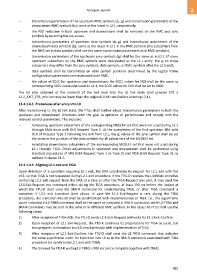Page 995 - 5G Basics - Core Network Aspects
P. 995
Transport aspects 2
– transmission parameters of the upstream RMC symbols (bi, gi) and transmission parameters of the
downstream RMC symbols (bi): same as the latest in L2.1, respectively;
– the PSD reduction in both upstream and downstream shall be removed on the RMC and sync
symbols by restoring the tssi values;
– transmission parameters of upstream data symbols (bi, gi) and transmission parameters of the
downstream data symbols (bi): same as the latest in L2.1 in the RMC symbols (the subcarriers from
the RMC set in data symbols shall use the same transmission parameters as in RMC symbols);
– transmission parameters of the upstream sync symbols (gi) shall be the same as in L2.1 (If some
upstream subcarriers on the RMC symbols were deactivated at the L2.1 entry, the gi on those
subcarriers may differ from the sync symbols, data symbols, or RMC symbols after the L2.1 exit);
– data symbols shall be transmitted on valid symbol positions determined by the logical frame
configuration parameters communicated over RMC;
– the values of SCCC for upstream and downstream: the SCCC values for NOI shall be the same as
corresponding SCCC values the latest in L2.1, the SCCC values for DOI shall be set to 0000.
The bit rate obtained at the moment of the exit back into the L0 link state shall provide ETR ≥
L2.1_EXIT_ETR_min, but may be lower than the original L0 bit rate (before entering L2.1).
13.4.1.4.3 Procedures after entry into L0
After transitioning to the L0 link state, the FTUs shall further adjust transmission parameters in both the
upstream and downstream directions with the goal to optimize L0 performance and comply with the
relevant control parameters. This includes:
– reinstating upstream subcarriers of the corresponding MEDLEY set that were not used during L2.1
through SRAs done with OLR Request Type 2. At the completion of the first upstream SRA with
OLR of Request Type 2 following the exit from L2.1, the gi values of the sync symbol shall be set
the same as the gi values of the data symbols for all subcarriers of the MEDLEY set.
– reinstating downstream subcarriers of the corresponding MEDLEY set that were not used during
L2.1 through TIGA. Other adjustments in upstream and downstream shall be performed using
standard procedures of SRA (OLR Request Type 1 or Type 2) and TIGA (OLR Request Type 3), as
defined in clause 13.2.
13.4.1.4.4 Aligning L2.1 exit and TIGA
Upon detection of a condition requiring L2.1 exit, the DRA coordinates its request for L2.1 exit with the
VCE, so that TIGA is not requested during L2.1 exit procedure. If the FTU-O receives the LinkState primitive
containing L2.1 exit request from the DRA at a time or after the TIGA-Request was sent, it may send the
L2.1-Exit-Request eoc command either during the TIGA procedure, at least 150 ms before the instant at
which the FTU-O shall send the SRA-R command for implementing TIGA, or after TIGA command is
complete, if L2.1 exit transition time allows. In case the L2.1-Exit-Request is sent during the TIGA
procedure, the transition into L0 shall be synchronized with implementation of TIGA, i.e., the superframe
count indicated in L2-TRNS command shall be the same as indicated in SRA-R command, while L2-TRNS and
SRA-R commands may be sent in the same or in different RMC symbols. In this case, the FTUs shall use the
following steps:
1) After reception of TIGA-ACK, the FTU-O sends L2.1-Exit-Request and waits for L2.1-Exit-Confirm.
2) Upon reception of L2.1-Exit-Request, the FTU-R continues its preparations for TIGA as usual, but
also prepares to transition into L0 simultaneously with implementation of TIGA.
3) After reception of L2.1-Exit-Confirm, the FTU-O shall send the L2-TRNS command that indicates
the same superframe count for transition into L0 as in the SRA-R command associated with TIGA
procedure (to synchronize L2.1 exit with TIGA).
4) The timeout for FTU-R waiting L2-TRNS is 900 ms (since complete together with TIGA).
985

